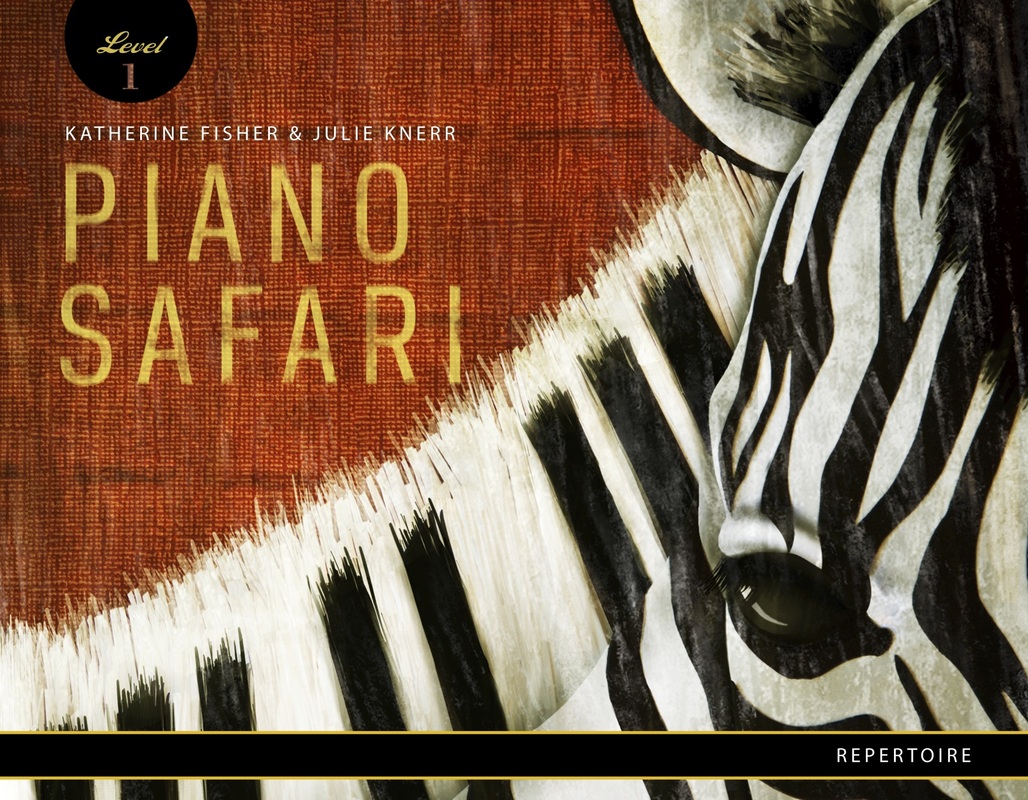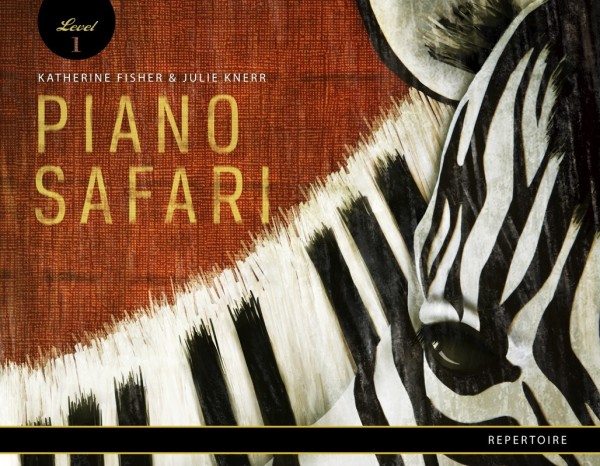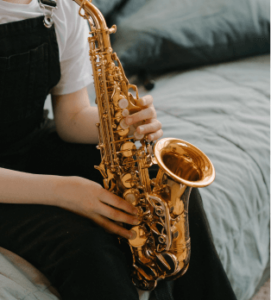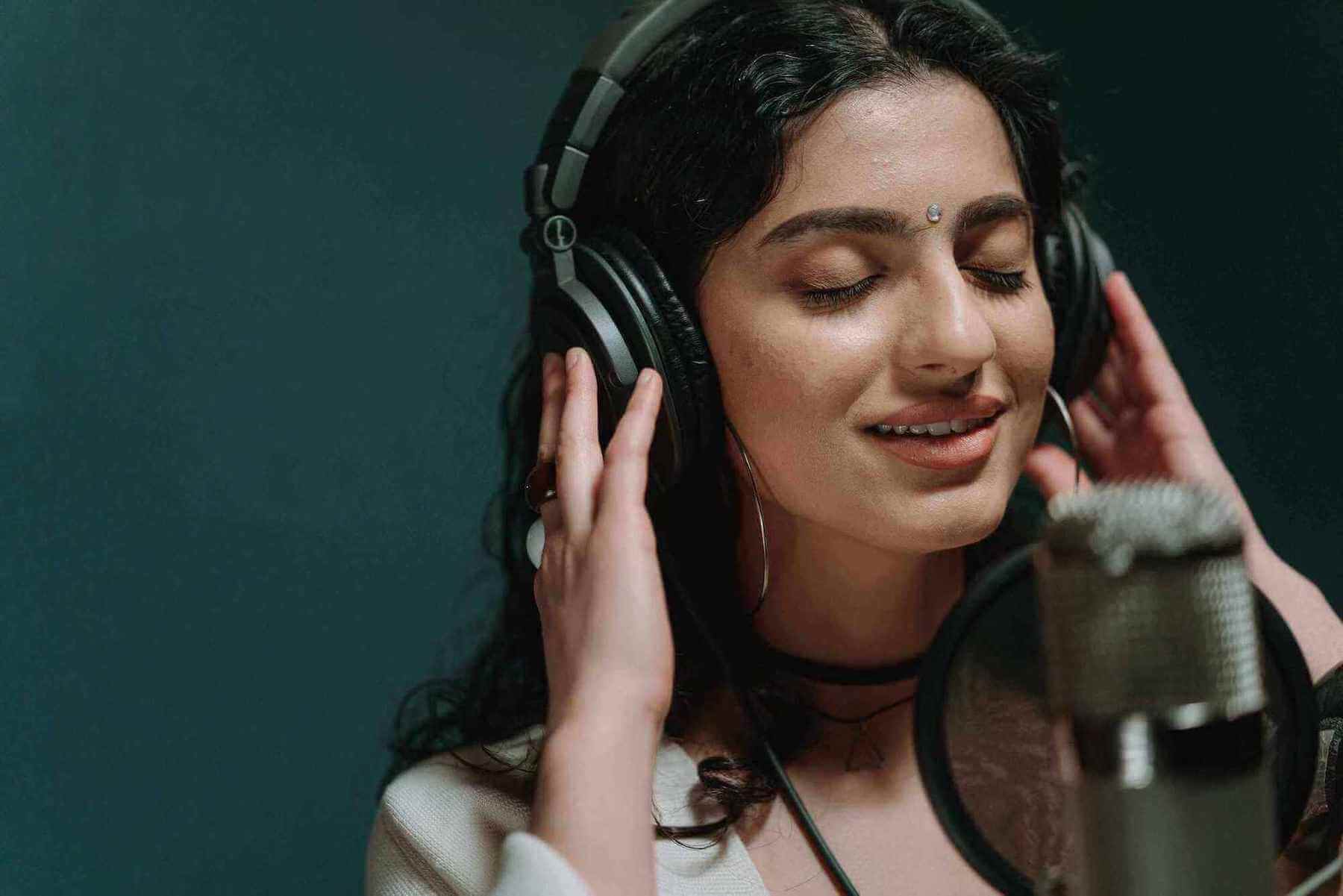
Color In My Piano
A blog dedicated to excellence in piano teaching.


The Technique Exercises of the Piano Safari method
On Friday, my local MTNA chapter held a workshop given by Katherine Fisher and Dr. Julie Knerr, co-authors of the Piano Safari method. Piano Safari has been on my radar for quite some time, although I have not yet used the method books with a student. I have, however, been experimenting with the technique exercises they have developed.

Piano Safari is a unique method in many ways, one of which is the integration of rote pieces alongside reading pieces.

Some time ago, I ordered their supplemental book “Technical Exercises & Rote Pieces” (view it in their online store here ). I was particularly interested in the technical exercises which are taught to students by rote. The exercises were developed based on Julie Knerr’s dissertation research in which she observed lessons taught by a handful of well-regarded piano teachers across the United States. She found commonalities in the ways these teachers taught technique and developed exercises based on those commonalities.
Below is a list of the seven exercises used in Book 1 of Piano Safari and the technical motions developed by each exercise:
- Lion Paw: Arm weight.
- Zechariah Zebra: Repeated notes with firm fingertips.
- Tall Giraffe: Non-legato articulation.
- Tree Frog: Legato articulation with arm bounce.
- Kangaroo: Repeated notes with firm fingertips.
- Soaring Bird: Legato articulation in a three-note slur.
- Monkey Swinging in a Tree: Rotation.
Below is a quick video by Katherine Fisher briefly demonstrating the exercises:
I am a big believer in the importance of giving even beginner students some kind of warmup exercise to play every day. In the past, my student’s warmup assignment generally consisted of a number of 5-finger patterns (aka pentascales) in various keys. But in recent months, my students have also been playing various incarnations of Zechariah Zebra and the other animal exercises. 🙂
Since incorporating the Piano Safari exercises, I have seen a huge improvement in my beginner students’ technique and overall physical ease at the piano. It is so beneficial for students to have a simple exercise/piece where their entire focus can be on developing the basic hand motions that are fundamental to making beautiful sounds at the piano.
Arm weight is an important example. Sometimes, students do not learn to utilize arm weight until very late in their piano study. Developing a beautiful tone and a beautiful legato touch is nearly impossible without the proper understanding and use of arm weight.
The wrist roll is another important example of a basic technical movement that is so often required in music. A wrist roll makes the end of any phrase or slur much more beautiful sounding.
At the Piano Safari workshop last Friday, I gained much more insight into the rest of the philosophies behind the Piano Safari method (besides technique, every method has a unique approach to note reading and rhythm). I purchased a complete set of books at the workshop and I hope to continue to experiment with this unique method with my students.
You can learn more about the Piano Safari method on their website , where you will find an array of pedagogy articles and videos. The books are available for purchase also on their website.
Don't miss a thing!
Sign up to get blog updates delivered to your email inbox.

Thanks for signing up! Check your email inbox now to confirm your subscription.
Published by Joy Morin
Joy Morin, MM, is a teacher, pianist, composer, speaker, and writer of a blog at ColorInMyPiano.com. A devoted teacher and lifelong learner, she teaches students of all ages at her independent piano studio near Ann Arbor, Michigan. Joy is a frequent attendee and presenter at conferences and workshops, and enjoys connecting with fellow piano teachers through her blog and beyond. View all posts by Joy Morin
7 thoughts on “The Technique Exercises of the Piano Safari method”
Interesting! I wish I can get the preview online, or perhaps will available in my country, since I also search a fun book to motivate my students to practice regularly 🙂
There are some previews on the website — take a peek here: http://pianosafari2.weebly.com/available-materials.html
Thanks for sharing. I’ve been curious about Piano Safari and I would love to be able to see a presentation about the method. Maybe we can get them to come do a workshop in Fort Worth sometime!
Or better yet AUSTIN!!… I am ordering today the technical exercises Please do come to Texas!
Great article! This is my first time hearing about the piano safari method!
I especially enjoy the lion paw exercise. Teaching arm weight is very difficult, and with this exercise, a student can begin working with arm weight at a young age. I personally disagree with the school of thought that weight should be taught once a student is more advanced.
I look forward to incorporating these exercises with my students one day!
Ha. I’m at a Piano Safari workshop in Athens, OH at OU and they just mentioned you and this blog in relation to rhythm notation cards.
Very cool, Karin! Thanks for letting me know. 🙂
Leave a Reply Cancel reply
Your email address will not be published. Required fields are marked *
Your Cart is Empty
- Skip to primary navigation
- Skip to main content
- Skip to primary sidebar
- Skip to footer
Music Matters Blog

Inspiring Creativity
Piano Safari: The Journey Begins…
February 20, 2014 by natalie 5 Comments
I remember sitting at a restaurant in Austin, TX with a group of fellow MTNA conference attendees in 2006 . Julie Knerr and Katie Fisher were among the group, and I sat with rapt attention as they flipped through pages of hand-drawn illustrations and notes while explaining the concept behind the new piano method they were creating. Little did I know that my own journey over the next six years would so perfectly prepare me for the official launch of Piano Safari !

I nearly leaped for joy when I read these two sentences in the Teacher’s Guide for Piano Safari : “In my use of various piano method series, I have come to believe that the main goal of most piano method series is not necessarily to teach children to play the piano. Instead, the goal of many method books is to teach children to read music notation at the piano.”
Ever since my epiphany at the conclusion of the Pattern Play Intensive and my subsequent experience at the Creative Life conference , I’ve been striving to teach in a way that reflects my desire to move away from a strictly literature-based approach to teaching, and adopt more of an experiential playing-based model of learning. In a sense, for the first 15 years of my teaching, I taught as though learning was the path to playing. But after experiencing a paradigm shift, I would now posit that the reverse is true: playing is the path to learning .

Piano Safari is the only method I know of that is based on this experiential and playing-based philosophy. Instead of reading music notation being the core, students are taught to develop beautiful technique, a sense of musicality, freedom to explore, discover, and create, an internal rhythmic pulse, and proficient sight-reading through a rich musical selection of rote pieces, improvisation experiences, guided compositions, and excellently sequenced reading skills.

The books are beautifully designed, with creative piece titles, memorable lyrics, and engaging music that is fun to play. I love that my students are learning eighth note rhythms right off the bat and getting to play music that sounds really cool. Learning by rote gives them freedom to focus on technique and explore lots of creative variations. They also learn to memorize quickly, and by the time they get to the end of the book, they have dozens of songs they can play by memory.

Piano Safari has revolutionized the way I teach and given me a framework to work within to provide a comprehensive and musically rich learning experience for beginning piano students. I am so grateful to Julie and Katie for creating this amazing method and providing myriad articles, videos, and other resources to help teachers successfully guide students onto a lifelong path as musicians. My students and I are loving the journey!
Share this:
- Click to share on Twitter (Opens in new window)
- Click to share on Facebook (Opens in new window)
- Click to share on LinkedIn (Opens in new window)
- Click to share on Pinterest (Opens in new window)
- Click to email a link to a friend (Opens in new window)
- Click to print (Opens in new window)
Reader Interactions
February 20, 2014 at 8:01 pm
Yes! I have been using Piano Safari this year and enjoying it. Also getting lots of wonderful help from the website – the teaching videos are great.
Paulette says
February 21, 2014 at 9:49 am
It looks great. (The other email address wasn’t correct)
Natalie Gibson Grimes says
February 22, 2014 at 8:55 am
I love the rote pieces in Piano Safari, and so do my students!
Laura Lowe says
August 15, 2018 at 8:37 am
Hi, Natalie! I’m intrigued by Piano Safari and thinking of using it to start a new student. However, he is a very young first grader. I had a little difficulty with getting him to focus at the interview, but of course, everything in my studio was new to him. My first instinct was to put him in the Faber My First Piano Adventure. So, I’m curious about whether you think that PS could work for a very young student.
natalie says
August 15, 2018 at 1:12 pm
Your student sounds like the perfect one for the Piano Safari method. I think it’s ideal for younger students because it incorporates so much rote learning and creativity instead of primarily an emphasis on reading music right off the bat. It’s a different enough approach that you’ll want to make sure you fully “buy into” the method (I recommend reading everything you can on their website and watching the teaching videos) because it won’t be effective if approached in a turn-the-page-for-the-next-song way. You have to do a little prep to know how you’re going to introduce the technique concepts and be prepared to teach the rote songs. But it is SO worth it! It has revitalized my teaching and I have had great success with every student who has used it!
Leave a Reply
Your email address will not be published. Required fields are marked *
Notify me of follow-up comments by email.
Notify me of new posts by email.
Free Resources
- Amazing Photos of Deconstructed Pianos
- Financial Resources for Independent Music Teachers
- Piano Music for Left Hand
- New Free Tortoises Beginner Piano Solo with Teacher Duet
- Free Piano Music from Composer Albert Rozin
Click for more Free Resources
Product Search
Blog archives, blog categories.
Advertisers and Affiliates

RSS Feed | YouTube | Twitter | Pinterest | LinkedIn | Facebook | Email
Blog content by Natalie's Piano Studio | © 2005-2024. All Rights Reserved. Sitemap | Privacy Policy | Terms and Conditions | Advertising Opportunities

- For Parents
- For School Owners
- Our Locations
- Teacher Application
- Dance Schools
- Music Schools

Piano Safari: A Great Piano Method Book for Children

Piano Safari Method Book: A Teacher’s Review
Why do I, a professional piano teacher, think Piano Safari by Julie Knerr is a great method book for children?
It has enjoyable tunes that are humorous and are fun for the young pianist to play and sing. Examples include “I Love Coffee, I Love Tea” and “Charlie Chipmunk.”
Many of the pieces in the Piano Safari books create analogies for children to understand such as bouncing like a kangaroo when they play the “Kangaroo” technique exercise to practice non legato playing and to create a relaxed and bouncy sound. Another example would be playing a loud, long note with a relaxed hand like a lion stuffed animal arm.
Learning Techniques & Activities

The Piano Safari method books consist of many learning techniques and activities that are useful to students and teachers. It contains reading pieces, sight reading exercises, rote pieces, theory, technique exercises, folk tunes, and improvisation. The book leans towards the Intervallic Reading Approach, but primarily uses an Eclectic Method.
Reading pieces in the Piano Safari Repertoire Book One start with just using black keys and printing all the finger numbers on the page for unit one. In unit two, students start playing on the white keys where the hand, note, and finger number are listed. All the finger numbers are also listed on the page. In unit three, students move to the grand staff. They use treble G as the landmark note for right hand and treble clef and bass C as the landmark note for left hand and bass clef. In Piano Safari Book One , students continue to stay on the landmark notes for the rest of the book.
In Piano Safari Book Two , middle C is added as a landmark note in both treble and bass clef. It is not until the middle of Piano Safari Book Two that the students graduate from the landmark notes and start using all the notes on the grand staff. Piano Safari slowly moves the students from black keys, to white keys, and then the grand staff so that students can feel comfortable with reading notes and move at a slow and steady pace. When students start learning the grand staff, intervals are slowly introduced.
In book one, students start with seconds and then move to thirds. In the rest of book one, students practice moving in between seconds and thirds. In book two, they learn fifths, then fourths, and practice playing all the intervals together. In book three, they learn the other intervals such as sixths, sevenths, and octaves. It is great that intervals are introduced at a slow and steady pace so that students can become comfortable with intervals before moving to harder repertoire and sightreading.

Sight Reading Exercises
For sight reading exercises, each method book has a set of color-coded sight reading card supplements, corresponding with the different units for each book or level. The cards are like flash cards. Each sight reading card in level one contains a melodic exercise for right hand in treble clef and a melodic exercise for left hand in bass clef.
In level one, the students will start marching the rhythms and use the syllable “ta” for the quarter notes, “ta-two” for half notes, “ta-ti” for eighth notes, and “ta-two-three-four” for whole notes. In level two, students graduate from marching and saying the ta’s. They move to metric counting, which is what professional musicians use.
For metric counting, the students do not march anymore, they tap the rhythms with both hands . The rhythmic exercises start simple at first such as the left hand playing whole notes while the right hand has a busy rhythm. The difficulty gradually goes up through each unit.
In level two and beyond, the cards will start including exercises where both hands play together. All the cards in every level and unit also contain a rhythmic exercise where the students only practice rhythms.
These methods help contribute to student reading skills.
Training to Play by Ear

One of the most unique activities that Piano Safari offers in its method books are rote pieces.
Rote pieces are ear training pieces where students learn how to play repertoire by ear. They are taught by playing the entire piece for the student first, and then dividing the music into different parts, usually line by line. I will teach one or two measures at a time to them and tell them to think of an animal or fruit name to help with the rhythm.
After the first one or two measures are comfortable with the student, I will gradually add on the next one or two measures and review the previous measures consistently until the first part is learned.
After that, I will use the same system for the second part, and the other parts after that. I also constantly review the previous parts. If there are two hands involved with different melodies and rhythms, I will teach one hand at a time and then teach the other hand.
Rote pieces can take up much time to teach, so typically when I teach a rote piece, I usually stretch it to at least two lessons. Piano Safari includes reminder videos on YouTube for the students to use to remember how to play the piece for when they practice at home.
In each Piano Safari level, a theory book is included that contains new material that the students learn in each unit. Students get to practice writing the different clefs, time signatures, notes, and intervals. The theory book also contains review material in each unit to keep up the students’ skills and help them remember previous material.
A unique aspect that the theory book has is compositional practice. This activity is when students are given the time signature, note values, which note to start on, and which intervals to use. Then, they are instructed to write a melody with the given material. The students are given the opportunity to come up with their own ideas or creative variations on the rote pieces.
Piano Safari contains technique exercises in each level that focus primarily on relaxation. In level one, technique exercises are part of the repertoire book and they start with simple exercises such as playing one note at a time with a strong and relaxed sound. In level two, there is a separate technique book from the repertoire book.
Also in level two, students will start learning basic five-finger patterns in different keys and start early practices into playing scales and arpeggios. Students will start playing triads first before getting into arpeggios. In level three, students start learning Hanon exercises and beginner etudes. Technique exercises are typically taught by rote, then the student reads the music, and lastly the student can transpose the exercise into different keys.
Folk tunes are part of the Piano Safari repertoire books. Usually they are pieces such as “Mary Had a Little Lamb,” “Baa, Baa, Black Sheep,” “The Duke of York,” and “The Bear Went Over the Mountain.” They are similar to the reading pieces where the students practice reading music, but they also use their ears to play the pieces.
Learning the folk tunes introduces students to playing familiar pieces and how to learn songs and pieces that they know on their own by ear and reading music.
Improvisational Exercises

Another interesting activity that Piano Safari offers in its repertoire books are improvisational exercises . In these exercises, the students are told which notes they can play, and the teacher plays a bass line and or a melody. The students play the notes that they are told to play in any order and can make up a rhythm if they stay in time with the teacher. Improvisational exercises allow students to be creative, explore sounds, and imitate the teacher.
Piano Safari Level Breakdown
Here is a break-down of all the different levels.
In Piano Safari level one, the students learn pre-staff notation, the grand staff is introduced, the intervals seconds and thirds are introduced, landmark notes are utilized, and students “march rhythms.” Level one includes a repertoire book, a theory book, and sightreading cards.
In level two, students graduate from landmark notes and start reading all the notes on the staff. They start tapping rhythms, have trickier sight reading examples, and they learn the intervals fourths and fifths. Level two includes a repertoire book, a theory book, a technique book, and sightreading cards. In level three, students learn the other intervals, they start playing more advanced music, and start learning early etude technique exercises.
Level Three
Level three has a repertoire book, a theory book, a technique book, and sightreading cards like level two.
Piano Safari offers all these great activities, and that is one of the reasons that I like to use it with children. My students who have used Piano Safari have developed good habits such as having excellent and relaxed piano technique, they do not look at their hands while reading music, they have a good understanding of rhythm, they are good at using their ears, and they enjoy music.
Enjoying music is the most important thing for students when taking piano lessons. The goal, as teachers, is to keep students wanting to practice and get excited to come to piano lessons. Piano Safari aids the teacher in putting together fun pieces that students enjoy playing and the activities keep students happy and engaged during piano lessons.
Why I Choose to Use This Method Book As a Teaching Guide
As a piano teacher myself, Piano Safari is my favorite method book to use because of all its fun activities it has for children. It goes along with my teaching philosophy which is teaching students good habits at an early age but also teaching them how to enjoy music.
Piano Safari is very helpful for the piano teacher in that it provides teaching guides and teaching videos for teachers to use. It is imperative that teachers always plan before having students, especially when using Piano Safari, because there is so much information to cover. For beginning students especially, piano teachers must plan to make lessons efficient.
When students become more advanced, teachers are mostly reactive to students, meaning students bring in repertoire and teachers aid them on what the students need help with. Piano teachers in general have so much to accomplish with their students. Teachers must break down difficult concepts into something that children can easily understand.
What I appreciate about Piano Safari is that it helps the teachers introduce concepts one at a time to students and slowly walks them through learning how to play piano and become great musicians .
To Conclude
I like to use the Piano Safari book with my students because it has the learning techniques of reading pieces, sight reading exercises, rote pieces, theory activities, technique exercises, folk tunes, and improvisation.
The blended Eclectic Method and intervallic approach create the best of two worlds. The result is a resource that provides students with a great way to read music notation, while learning interesting musical styles and listening skills.
All of Piano Safari’s exercises include fun and silly songs that help students learn to enjoy music and is entertaining for the teachers to teach and introduce new material. I am hopeful that Piano Safari will start to become more popular in the piano teaching world and that more piano teachers will start using this method book for beginning students.
My students have really shown great progress with Piano Safari and they continue to play music and be successful with learning new material. As a music teacher, my goal is to introduce Piano Safari to different piano teachers and encourage teachers to introduce good, early habits and techniques to students so that one day they can become successful pianists.
Author: Marisa Pickard
Marisa Pickard is currently a graduate student at DePaul University studying piano performance and teaches at the Christopher Laughlin School of Music in Northbrook, IL . She earned her Bachelors of Music in piano performance from the University of Alabama. Being an experienced piano teacher, she has taught piano lessons for five years and has served as president of the Music Teachers National Association chapter at the University of Alabama. During one summer, she participated in the Brevard Music Center Summer Institute.

Bibliography
“About Piano Safari.” Piano Safari. Accessed June 4, 2021. https://pianosafari.com/about/about-piano-safari/.
Crappell, Courtney. Teaching Piano Pedagogy: A Guidebook for Training Effective Teachers . New York: Oxford University Press, 2019.
Fisher, Katherine and Julie Knerr. Piano Safari Repertoire Book I . Piano Safari, LLC, 2018.

Start your musical journey today
Terms and Conditions - Privacy Policy
Piano Safari Review
by Lauren Lewandowski | Feb 20, 2015 | Reviews
June 2017 Update:
Since writing this review in 2015, I have been teaching the Piano Safari method consistently for two years. I have used it with beginners, adults, and transfer students. I have been extremely impressed with the way students are able to read music by the end of Level 2. This is by far my favorite method for teaching piano!
As I’ve been teaching the series, I’ve also made some supplements along the way. Be sure to check out the free downloads on this page in addition to the Grand Staff Note Speller . The Grand Staff Note Speller coordinates with Level 2 of Piano Safari .

I’ve been very interested in Katherine Fisher and Julie Knerr’s piano method, Piano Safari . I’ve studied piano method books in piano pedagogy courses and am constantly trying new ones with students. Piano Safari is by far the most comprehensive method I’ve seen.
I played through the Level 1 Pack , which includes:
- Repertoire Book
- Sight Reading & Rhythm Cards
- Listening CD
Piano Safari not only uses an intervallic approach to note reading, but also includes rote pieces. The rote pieces will develop the student’s listening skills from the very beginning. The student can use the listening CD to listen to rote pieces before learning the piece with a teacher. The rote pieces allow the student to develop his or her technique and to play beyond the typical level of a first-year student. In the Level 1 Repertoire book, students learn seven different motions (named after animals) that provide a solid foundation for piano technique.
An initial concern for learning rote pieces would be that reading skills might suffer during the time of learning by rote. The teacher can easily supplement learning by rote with the Sight Reading & Rhythm Cards. Each sight reading & rhythm card includes a reading and rhythm example.
The Level 1 Pack is intended to take about a year with students. It may seem like a long time for just one level, but I agree with the creators that the first year is crucial for laying a solid foundation for students.
What if a student is already learning from a different method?
The rote pieces can be purchased as a separate book that also comes with a listening CD. Students can still learn the rote pieces and “animal techniques” while using a different method book. The Sight Reading & Rhythm Cards can also be used without using the repertoire book. I ordered all three levels of the Sight Reading & Rhythm Cards to use with students.
Katherine Fisher and Julie Knerr have a wealth of resources for teachers available on their website . There are teacher guides, videos, and articles.
Katherine and Julie have offered a giveaway of the level one pack to one reader of my blog. If you are interested in trying Piano Safari , leave a comment at the end of this article by February 28. One person will be randomly selected to receive a free Piano Safari level one pack.

Lauren teaches piano to students of all ages. She enjoys creating resources for her students and teachers. She is the author of Ready for Theory®. For personalized help, check out the consultations page for teachers .
Related posts:

12 Comments
I’m so intrigued by the rote pieces and also the seven animal motions! I think the cards will work really well with some of my students!
This sounds interesting! Count us in!
I like the idea of also using rote to develop listening skills!
This is the best explanation I’ve read of Piano Safari! I now understand how it works and am ready to try it! Thank you!
I love Piano Safari! I have been using it with great success this past year. My students really love the rote pieces.
I have taught for over 30 years and have only used this with one student so far, but it will be my choice for all beginners from now on. It is particularly wonderful for the older beginner as it is void of all the cutesy illustrations. Very respectful and so much is covered.
I’m definitely intrigued!
I’m loving Piano Safari – have been using it with students for about 1 year. It’s not just the rote pieces but the excellent introduction to the fundamental movements required for good piano technique. The internet reminder videos demonstrating exercises and rote pieces are a great resource for students – and they provide a great teacher’s guide, mini essays and other pedagogical resources too.
I have been looking forward to exploring these materials!
This looks interesting. I really like the idea of rote pieces.
is this also for kids?
Yes, it works well for children. I’ve been using it with a 4-year-old and a 9-year-old this year.
Trackbacks/Pingbacks
- Teaching Piano Pieces by Rote | Piano with Lauren - […] February, I wrote a review of the method, Piano Safari. One of the elements of Piano Safari is rote…
- New Product! Grand Staff Note Speller (PDF Download) | Piano with Lauren - […] method. By the way, if you aren’t familiar with the method, be sure to check out my review here. It…
Quick Search
Blog categories.
- Games & Activities
- Group Lessons
- Monthly Updates
- Online Lessons
- Popular Posts
- Ready for Theory
- Repertoire Lists
- Teaching/Practice Tips
- Uncategorized
Consultations for Teachers


Introducing the Piano Safari Pedagogy Institute
Are you a piano teacher seeking to enhance your skills? The Piano Safari Pedagogy Institute provides teachers with comprehensive training courses led by the authors. In addition to a thorough survey of the Piano Safari method, the courses will cover general pedagogical topics such as lesson planning, group teaching, student motivation, parental involvement, practice, and technique.
Instructors
Sign up for the Piano Safari Pedagogy Institute today, and embark on a journey that will enrich your teaching and inspire your students. Join a community of dedicated piano educators and discover the full potential of the Piano Safari approach.

IMAGES
VIDEO
COMMENTS
Metamorphosis is from Piano Safari Level 2. You can find the books at www.pianosafari.com be sure to order there. If you order them off Amazon it comes from ...
How does Metamorphosis go you wonder? Well check out Jan playing it, and then play along with him!Since 2012, Classic Studios Music Academy has helped hundre...
Is this the way you learn to play? Classic Studios offers in-studio and in-home lessons in Edmonton and Sherwood Park. Call us today, at 780-940-2738, to f...
Below is a list of the seven exercises used in Book 1 of Piano Safari and the technical motions developed by each exercise: Lion Paw: Arm weight. Zechariah Zebra: Repeated notes with firm fingertips. Tall Giraffe: Non-legato articulation. Tree Frog: Legato articulation with arm bounce.
Piano Safari Offers: A carefully sequenced, intervallic approach for learning to read music notation Patterned pieces taught by rote that provide engaging music for students from the first lesson Animal themed Technique Exercises that teach the basic motions of piano technique Improvisation ideas for developing creativity A holistic approach combining ears, eyes, and imagination that allows ...
PIANO SAFARI ® REPERTOIRE BOOK 2 ... 3 Metamorphosis Rote 56 3 Minuet, Op. 1, No. 1 Challenge 58 4 Interval Review Theory 2nds, 3rds, and 5ths 60 4 Rhythm Theory 62 4 The Gallant Knight Reading 63 4 Sweet Acacia Reading/Duet 64 4 Ode to Joy Reading 66 4 Bear Dreams Reading 68
Metamorphosis Reminder Video. Rainbow Colors Reminder Video . Shop Home Login/Register. Your Cart. Search Piano Safari. Search for: Search. Shop Piano Safari
The Piano Safari Method, by Katherine Fisher & Julie Knerr Hague, is an innovative piano method for children ages 6 - 10. The main Piano Method series has three levels. Piano Safari presents a well-rounded approach to music development at the piano that includes Rote Pieces (imitating the teacher's notes, rhythm, technique, and phrasing ...
Piano Safari: The Journey Begins…. February 20, 2014 by natalie 5 Comments. I remember sitting at a restaurant in Austin, TX with a group of fellow MTNA conference attendees in 2006. Julie Knerr and Katie Fisher were among the group, and I sat with rapt attention as they flipped through pages of hand-drawn illustrations and notes while ...
The Piano Safari method books consist of many learning techniques and activities that are useful to students and teachers. It contains reading pieces, sight reading exercises, rote pieces, theory, technique exercises, folk tunes, and improvisation. The book leans towards the Intervallic Reading Approach, but primarily uses an Eclectic Method.
After Piano Safari Level 3. By the end of Level 3, students will be playing at an intermediate level. Piano Safari Level 3 is a bit more advanced than other methods' Level 3 books. It includes advanced coordination, reading, and technical skills, mostly through classical etudes. More on the song selection in a bit.
Reminder Video for Metamorphosis by Katherine FisherRote Piece from:Piano Safari Repertoire Book 2 & Piano Safari for the Older Student Level 2by Katherine F...
LEVEL 2 ROTE LEARNING REMINDER VIDEOS. Safari Friends. Shadows at Dusk. African Safari. Flamingo Dancers. Metamorphosis. Monsters on the Run. Jubilation. Rainbow Colors.
Lauren Lewandowski. Lauren teaches piano to students of all ages in New Orleans, LA. Teaching is her passion. She enjoys creating resources for her students and is the author of Ready for Theory®. Piano Safari review of Katherine Fisher & Julie Knerr's piano method book. The creators have also offered a free giveaway of the level 1 pack.
Level 1 products include: Level 1 Pack - Includes Repertoire Book 1 and Sight Rhythm & Reading Cards 1. The Pack contains the core of the method and is designed to promote the well-rounded development of each student. Repertoire Book 1 - Included in the Level 1 Pack. Contains repertoire, technique, improvisation, and some theory pages.
Authors: Katherine Fisher, Julie KnerrFormat: Book with Audio OnlineInstrumentation: Pianois designed to supplement any standard piano method. As the name implies, it contains pattern-based pieces that are to be taught by rote. A code for corresponding digital audio tracks is included in the front of the book.co
Welcome to the 628DirtRooster website where you can find video links to Randy McCaffrey's (AKA DirtRooster) YouTube videos, community support and other resources for the Hobby Beekeepers and the official 628DirtRooster online store where you can find 628DirtRooster hats and shirts, local Mississippi honey and whole lot more!
In 1938, it was granted town status. [citation needed]Administrative and municipal status. Within the framework of administrative divisions, it is incorporated as Elektrostal City Under Oblast Jurisdiction—an administrative unit with the status equal to that of the districts. As a municipal division, Elektrostal City Under Oblast Jurisdiction is incorporated as Elektrostal Urban Okrug.
Elektrostal is a city in Moscow Oblast, Russia, located 58 kilometers east of Moscow. Elektrostal has about 158,000 residents. Mapcarta, the open map.
Repertoire Book 2. A Prairie Dog Companion. Performance Video. African Safari. Reminder Video. Performance Video. All the Pretty Little Horses. Performance Video.
State Housing Inspectorate of the Moscow Region Elektrostal postal code 144009. See Google profile, Hours, Phone, Website and more for this business. 2.0 Cybo Score. Review on Cybo.
Piano Safari is a piano method that incorporates the best elements of a range of techniques for teaching children and older students. Katherine Fisher and Dr. Julie Knerr Hague combined decades of experience and a variety of teaching and pedagogical research into a detailed, effective method. Piano Safari contains multiple levels of repertoire ...
The Piano Safari Pedagogy Institute provides teachers with comprehensive training courses led by the authors. In addition to a thorough survey of the Piano Safari method, the courses will cover general pedagogical topics such as lesson planning, group teaching, student motivation, parental involvement, practice, and technique.